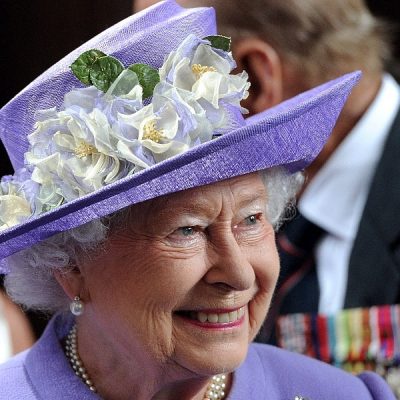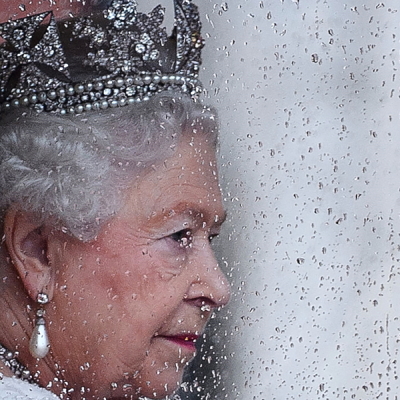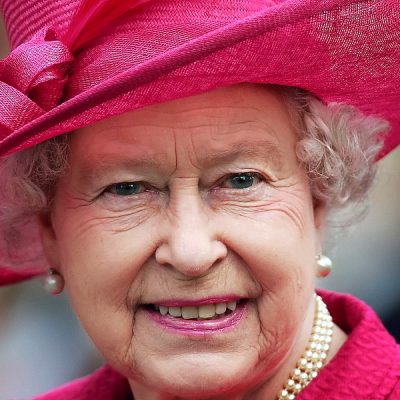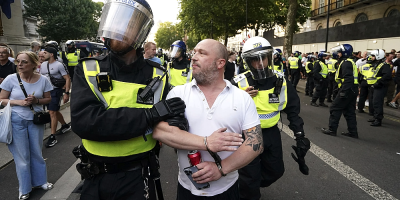
BALLATER, UK: Queen Elizabeth II, the longest-serving monarch in British history and an icon instantly recognizable to billions of people around the world, died at her Scottish Highland retreat on Thursday. She was 96.
The eldest of her four children, Charles, Prince of Wales, who at 73 was the oldest heir apparent in British history, became king immediately.
Royal officials confirmed he is now known as King Charles III — the first king of that name to sit on the throne since 1685.
His mother’s death triggered an outpouring of condolences across the globe as world leaders paid homage to a woman whose reign spanned 70 years, straddling two centuries of seismic social, political and technological upheaval.
Hundreds of flowers and flickering candles were left at the gates of Buckingham Palace in central London, as billboards lit up in tribute across the capital with images of the queen.
In his first words as monarch, Charles called her death “a moment of the greatest sadness for me and all members of my family.”
“We mourn profoundly the passing of a cherished Sovereign and a much-loved Mother,” he added in a statement signed “His Majesty the King.”
“I know her loss will be deeply felt throughout the country, the Realms and the Commonwealth and by countless people around the world.”
Buckingham Palace announced the queen’s death in a short statement, triggering 10 days of national mourning and a global outpouring of tributes to her long life and record-breaking reign.
“The Queen died peacefully at Balmoral this afternoon,” said the statement issued at 6:30 pm (1730 GMT).
“The King (Charles) and The Queen Consort (Camilla) will remain at Balmoral this evening and will return to London tomorrow.”
From the steps of 10 Downing Street, Prime Minister Liz Truss — who learned of the death two hours before it was announced — mourned “the passing of the second Elizabethan age” nearly 500 years after the first.
“God save the king,” she concluded, in words not uttered in Britain since 1952.
Seismic change
The queen’s death came after the palace announced earlier on Thursday that doctors were “concerned” for her health and recommended she stay under medical supervision.
All her children — Charles, Princess Anne, 72, Prince Andrew, 62, and Prince Edward, 58 — flocked to her Scottish Highland retreat, Balmoral.
They were joined by Charles’s elder son, Prince William, and William’s estranged brother Prince Harry.
Andrew, Edward and William were photographed arriving at around 5:00 pm, after the queen had passed away. Harry, who traveled separately, arrived later in the evening.
Just two days earlier, she performed one of her core ceremonial functions as head of state, appointing Truss as the 15th prime minister of her reign, which started with Winston Churchill in power.
She was seen smiling in photographs but looking frail and using a walking stick.
One photograph of the meeting with Truss sparked alarm, showing a deep purple bruise on the monarch’s right hand.
She came to the throne aged just 25 in 1952 in the exhausted aftermath of World War II, joining a world stage dominated by political figures from China’s Mao Zedong to Soviet leader Joseph Stalin and US president Harry S. Truman.
Her tenure saw the last vestiges of Britain’s vast empire crumble. At home more recently, Brexit divided her kingdom, and her family endured a series of scandals.
But throughout, she remained popular and was queen and head of state not just of the United Kingdom but 14 former British colonies, including Australia and Canada. New Zealand proclaimed Charles its new king.
Tearful crowds
She was also head of the 56-nation Commonwealth, which takes in a quarter of humanity, and supreme governor of the Church of England, the mother church of the worldwide Anglican communion.
But questions will be asked about whether the golden age of the British monarchy has now passed and how an ancient institution can remain viable in the modern era.
Debate swirls over whether Charles will command the same respect or reign in his mother’s shadow.
Under leaden skies at Buckingham Palace, emotional crowds sang a forlorn “God Save the Queen” — the national anthem which now becomes “God Save the King” — as news of her death filtered through.
“I know she is 96, but there is still a sense of shock,” tearful Londoner Joshua Ellis, 24, told AFP.
“You could always look to the queen, on a sense of stability.”
Currency broker Charlie Wolstenholme said the news was hard to bear.
“She’s been the queen for as long as my parents have been alive,” he added. “She’s really a very, very important part of the fabric.”
Historians have characterized the queen’s reign as a period of inevitable decline for Britain from what some believe to be its greatest reference point — victory in World War II.
“We were all told that the funeral of Churchill (in 1965) was the requiem for Britain as a great power,” one historian told The Guardian newspaper in 2017.
“But actually, it will really be over when she goes.”
Royal author Phil Dampier told AFP she would undoubtedly be remembered as “the longest serving but also the greatest” monarch in British history.
“She lived through the most dramatic changes in the modern era of any monarch… It is going to be an impossible act to follow.”
Official mourning
Television and radio stations interrupted regular programming to broadcast the news, with long-rehearsed special schedules set in place to remember her long life and reign.
The national anthem was played. Flags were lowered and church bells tolled to remember a woman once described as the “last global monarch.”
An official notice, edged in black, was posted behind glass at the gates of Buckingham Palace and other royal palaces, while the family’s official website also turned black.
Truss said: “It’s an extraordinary achievement to have presided with such dignity and grace for 70 years. Her life of service stretched beyond most of our living memories.
“In return she was loved and admired by the people in the United Kingdom and all around the world.
“Today the crown passes as it has done for more than 1,000 years to our new monarch, our new head of state, His Majesty King Charles III.”
The period of national mourning, which begins officially on Friday, will culminate in a final public farewell at Westminster Abbey in London.
In the United States, President Joe Biden ordered flags be lowered to half-mast at the White House, other federal buildings as well as military and diplomatic sites globally.
He lauded the queen as a “stateswoman of unmatched dignity”.
“She helped make our relationship special,” he said, adding he looked forward to working with her successor, noting their already “close friendship.”
 |
 |
 |
 |
 |
 |
Longevity
Charles’ coronation, an elaborate ritual steeped in tradition and history, will take place in the same historic surroundings, as it has for centuries, on a date to be fixed.
Elizabeth Alexandra Mary Windsor was for most of her subjects the only monarch they have ever known — an immutable figurehead on stamps, banknotes and coins.
Diminutive in stature yet an icon of popular culture, she was at the center of it all, instantly recognizable in her brightly colored suits and matching hat, with pearls, gloves and a handbag.
During her reign, the royals went from stiff, remote figures to tabloid fodder and were then popularized anew in television dramas such as “The Crown,” watched by tens of millions worldwide.
Her time on the throne spanned an era of remarkable change, from the Cold War to the 9/11 attacks, from climate change to coronavirus, “snail mail” and steam ships to email and space exploration.
She came to be seen as the living embodiment of post-war Britain and a link between the modern era and a bygone age.
When the queen was crowned in 1953, Britain was a predominantly white, Christian country of 50 million people.
At her death, the population had swollen to 66 million and more classed themselves as British Asian, black British or of mixed heritage.
Now, one in seven people were born outside the UK, the legacy of waves of immigration, from the Caribbean and Uganda, to India, Pakistan and Bangladesh from the 1950s onwards.
Mosques and temples became as common — and largely unremarkable — a sight as churches; Diwali and Eid were celebrated alongside Christmas, and Indian food — or at least its Anglicized hybrid chicken tikka masala — vied for primacy as the national dish with fish and chips.
As mother of Britain’s most famous family, she retained huge public support throughout, surviving even a backlash in the wake of the shocking death of Charles’s first wife, Diana, in 1997.
More recently, the royal family was rocked by claims from Prince Harry and his mixed-race wife Meghan of racism in the royal family.
She also endured a scandal involving her second son Prince Andrew, whose friendship with convicted sex offenders Jeffrey Epstein and Ghislaine Maxwell saw him settle a civil claim for sexual assault in the United States.
‘Blitz spirit’
Britons were jolted into recognizing the beginning of the end of her reign when in April 2021 she lost her beloved husband of 73 years, Prince Philip, Duke of Edinburgh.
Yet the palace had long recognized her mortality and the transition to Charles was already well under way.
He, Prince William, who now becomes heir, and his wife, Catherine, began to assume more of the queen’s official roles.
The coronavirus pandemic and her advanced years forced her into the splendid isolation of Windsor Castle, west of London.
But from behind its stately walls, she remained a reassuring presence, popping up on video calls with members of the public.
In a rare, televised address during the first lockdown, she recalled the “Blitz spirit” of Britain under siege during World War II that defined her generation.
“We will meet again,” she said.
She cast off the shroud of Philip’s death and her enforced confinement to resume public duties, but age and ill-health slowed her down.
After an unscheduled night in hospital in October 2021 following undisclosed health tests, her appearances became rarer.
“None of us will live forever,” she told world leaders attending a UN climate change summit soon afterwards, urging them to leave a legacy for generations to come.
One of her last decisive acts was to settle an unanswered question for the succession, giving her blessing for Charles’s second wife, Camilla, to be called “queen consort.”
ADVERTISEMENT
ADVERTISEMENT




















































